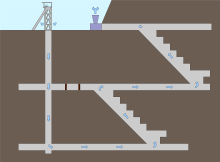- Underground mine ventilation
-
Underground mine ventilation provides a flow of air to the underground workings of a mine of sufficient volume to dilute and remove noxious gases (typically NOx, SO2, methane, CO2 and CO). The source of these gases are equipment that runs on diesel engines, blasting with explosives, [1] and the orebody itself. [2] The largest component of the operating cost for mine ventilation is electricity to power the ventilation fans, which may account for one third of a typical underground mine's entire electrical power cost.[1]
Contents
Types of ventilation
Flow-through ventilation is the main ventilation circuit for the mine. Air enters the mine from surface via a shaft, ventilation raise or adit. The air is distributed through the mine via internal ventilation raises and ramps, and flows are controlled by regulators and permanently mounted ventilation fans. An Auxiliary ventilation system takes air from the flow-through system and distributes it to the mine workings via temporarily mounted ventilation fans, venturies and disposable fabric, or steel ducting.
Regulations
The volume (expressed in cubic feet per minute or cubic meters per second) of air required to ventilate an underground mine is determined by mining- or geotechnical-engineers. It may also be regulated by the local governing body. However in some developing countries the mandated ventilation requirement may be insufficient, and the mining company may have to increase the ventilation flow, in particular where ventilation may be required to cool the ambient temperature in a deep hot mine.[1]
Heating
In temperate climates ventilation air may require to be heated during winter months. This will make the working environment more hospitable for miners, and prevent freezing of workings, in particular water pipes. In Arctic mines where the mining horizon is above the permafrost heating may not take place to prevent melting the permafrost. "Cold mines" such as Raglan Mine and Nanisivik Mine are designed to operate below zero degrees Celsius.[1]
References
Categories:- Underground mining
- Mine ventilation
Wikimedia Foundation. 2010.

